Anatomy > EXAM > BIO 152 AP II Module 7 Exam (HIGHLY RATED PAPER) Questions and Answers solutions | 100% Guaranteed P (All)
BIO 152 AP II Module 7 Exam (HIGHLY RATED PAPER) Questions and Answers solutions | 100% Guaranteed Pass
Document Content and Description Below
Module7Exam -RequiresRespondus LockDownBrowser+Webcam True/False:Thekidneysarelong,thinmusculartubes. True False ApersonsustainedbluntforcetraumatothebackatheL1level,withnospinalcord... injury. Wouldyoususpecthekidneystobedamaged?Whyorwhynot? YourAnswer: Thekidneywouldbedamagedsincethekidneysarelocatedbetwe ntheT-12andL-3 vertebrae Yes,thekidneysliebetwe ntheT-12andL-3 Describetheconsistencyandpurposeoftherenaladiposecapsule. YourAnswer: Therenaladiposecapsuleisafatylayerofthekidneythatprotectsthekidneyfrom trauma. Outsideoftherenalcapsuleisafatylayerthatprotectsthekidneyfrom trauma. Namethelayerandthepartsofthenephronslocatedintheregionhighlightedinblue, below. YourAnswer: Nameoflayer:Cortex Partsofthenephronwithinthecortex:Glomerularcapsule,distalconvolutedtubuleand proximalconvolutedtubule Locatedwithinthecortexaretheglomerularcapsuleandthedistalandproximal convolutedtubulesectionsofthenephrons. Thesearteriesdivideintothesegmentalarteriesastheyflowintothekidney. Afferent Lobar Interlobular Arcuate Interlobar Renal Afterfiltrationocurs,nextblo dtravelsintothesevessels. Efferentarteriole Lobarveins Interlobularveins Arcuateartery Interlobarvein Vasarecta Nametheregioninthediagram below,indicatedbytheredarrow. YourAnswer: Lo pofHenle Lo pofHenle(thindescending) Whichofthefolowingisfalseabouthelocationoftheblad er? A. Inmales,theblad erisanteriortotherectum. B. Infemales,theblad erisposteriortotheuterus. C. Infemales,theblad erisinbetwe ntherectum andtheuterus. D. Inmales,theblad erisabovetheprostategland. E. B&Carefalse F. A&Darefalse Discusstwofeaturesoftheblad erthatalowforexpansion. YourAnswer: Rugae(folds)withintheblad erwalincreasesthesurfaceareaoftheblad ersothat theblad ercanholdmoreurine Theblad erisalsoelasticandthisalowsitoexpand (Anytwoofthefolowingareac eptableresponses) 1- Themuscularwalstretchesandthinsalowingtheblad ertostorelarger amountsofurinewithoutasignificantriseininternalpres ure. 2- Rugae(foldsintheblad erwal)alsoextendtohelpthecapacityoftheblad er internaly. 3- Transitionalepithelium celsarespecializedtoenablecelularexpansionto absorbfluid. Anelderlymaleisunabletomicturate.Whatismostlikelycausingthedifficulty? Incontinenceduetoendstagedementia Incontinenceduetoswolenseminalvesicle Urinaryretentionduetospinalcordinjury Urinaryretentionduetoenlargedprostate Urinaryretentionistheinabilitytoexpelstoredurine. Hematuriaduetodiabetes Thisisthesmalestregionofthemaleurethra. Spongy Prostatic Membranous Ejaculatoryduct Ureters Describethedifferencebetwe nthetwotypesofnephrons. YourAnswer: Corticalnephrons-inthecortexofthekidney(exceptforapartoftheLo pofHenle) Juxtamedularynephron-inthemedula,longerLo pofHenle -Corticalnephronsareinthecortexregionofthekidney,exceptforaportionof theirlo pofHenlewhichextendsintothemedula. -Theremainingnephrons,caledjuxtamedularynephrons,pas de plyintothe medulabecauseoftheirlocationandtheirlongerlo psofHenle. Micturitioncanbecontroledconsciouslybecauseof: Voluntarycontrolovertheinternalsphincter Involuntarycontrolovertheinternalsphincter Voluntarycontrolovertheexternalsphincter Involuntarycontrolovertheexternalsphincter Voluntarycontroloverthevisceralreflexarc Noneoftheabove:micturitioncan otbevoluntarilycontroled Thisistheblo dpressuredrivingfluidoutofthecapilaries: Coloidosmoticpressure Capsularpressure Netfiltrationpressure Glomerularfiltrationrate Hydrostaticpressure Calculatethenetfiltrationpressureforyourpatientgiventhefolowingvalues.Show yourwork.(Notalvalueslistedmaybeused). -Capsularpressure=20 -Hydrostaticpressure=70 -Coloidosmoticpressure=30 -GFR=130 YourAnswer: HP-(COP+Capsularpressure) =70mmHg-(30mmHg+20mmHg) =70mmHg-50mmHg =20mmHgisthenetfiltrationpressure (Outgoingforces–incomingforces) HP-(COP+Capsularpres ure) 70mmHg-(30mmHg+20mmHg)) =20mmHg(netoutwardpres ure) Question16 2/5pts Describeindetailhowthekidneycontrolsitsownrateofblo dflowthroughthenephron. YourAnswer: Hormonalcontrolbywayofthehormone,aldosteronethatissecretedbytheadrenal glandabovethekidneys.ThishormoneisundercontrolbytheRAAsystem. ALdosteroneincreasestheblo dvolume. Thisiscaledrenalautoregulationbecausethekidneydeterminesitsownrateof blo dflowbycontrolingthediameteroftheafferentandefferentarterioles.By meansofthisautoregulatorysystem,thekidneycanmaintainaconstantGFR despitevariationsinthearterialblo dpres ureintherestofthebody. epinephrinebytheadrenalmedula WhichofthefolowingstatementsisfalseconcerningtheRAAsystem? Aldosteronecausestheretentionofsodium ions. Itrespondswhenblo dpressurebecomesto high. Angiotensin Iactstocausevasoconstrictioninblo dvessels. Reninisreleasedbythecelsinsidethenephron. ReninconvertsangiotensinogentoangiotensinI. Thegreatestamountof ocursinthecelsofthePCT. Reabsorption Excretion Secretion Countercurentflow Osmolarity TrueorFalse:Na+canleavetheascendinglimbbutnothedescendinglimb. True False WhichofthefolowingisfalseconcerningADH? ADHisproducedbythehypothalamus. ADHisproducedinresponsetodehydrationconditions. ADHretainsupto9 % ofwaterinthefiltrate. ADHdoesnotrespondduringsevereblo dloss. ContrastheosmolarityofthePCTandthebotom ofthelo pofHenle.Explainwhythereis suchacontrast. YourAnswer: Soluteconcentrationincreasesasthelo pofHenledescends(higherosmolarity) becausewaterisleavingthissegmentofthelo pofHenlebyNa+saltsarenot.The soluteconcentrationofthePCTisthesameastheplasmaconcentrationandislower thanthesoluteconcentrationinthebotom ofthelo pofHenle • TheosmoticcharacteristicsofthefiltrateenteringthePCTisidenticaltothe suroundingplasma,around30 mOsm/L.Inthedescendinglimbofthelo p ofHenle,thesoluteconcentrationincreasesasitdescends.Oncethefiltrate reachesthehairpinturnofthelo pinthein ermedula,thefiltrateincreases toabout120 mOsm/L. • Theconcentrationofthesoluteincreasesdrasticalybecausewaterleavesthe descendinglimbbutnotsalt Describetheactionofaldosteroneontheconcentrationsofsodium andpotassium inthefiltrate. YourAnswer: AldosteroneincreasesNa+reabsorptionandincreasespotassium secretionthroughthe sodium-potassium pump.Potassium isexcretedinurineassodium ispumpedoutofthe filtrateandthenreturnedtotheblo d. Sodium ispumpedoutofthefiltratetobereturnedtotheblo dwhilepotas ium (K+)isexcretedinurine. Describetheactionofalcoholonurinaryoutput. YourAnswer: Alcoholwouldincreaseurinaryoutput AlcoholisatypeofdiureticthatinhibitsthereleaseofADH. inhibitsthereleaseofADH Whichofthefolowingistrueconcerningcardiovascularbaroreceptors? Theyaremechanoreceptorsfoundintheaorticarchandcarotidsinus. Theyareinthelungsandthekidneys. Thesearechemoreceptorsfoundinthehypothalamus. Theyareregulatedbythehypoglossalandspinalacessorycranialnerves. Yelowcolorinurineisduetothepresenceof: Pus Rhubarb Asparagus Urochrome Fruit Waterinthebodyisprimarilyfoundinwhatbodycompartment? Extracelular Intracelular Interstitial Plasma Synovialjoints UrinewithapHof9.0is: withinnormalrange;acidic withinnormalrange;alkaline outsidenormalrange;acidic outsidenormalrange;alkaline withinnormalrange;neutral Theproteinbuffersystem: generalytakesseveralhourstorespond. causeshyperventilationintherespiratorysystem. isthemainbuffersystem oftheinterstitialfluid. isthemainbuffersystem oftheintracelularfluid altheabovearetrueoftheproteinbuffersystem Hypoventilationisapartofwhatcontrolmechanism?Explainwhathypoventilation acomplishes. YourAnswer: RespiratoryControlMechanism Withhypoventilation,therespiratoryratedecreasesanditalowsforanincreaseinCO2 • Respiratorycontrol-Ifblo dpHbeginstorise(becomemorealkaline),the respiratorycenterisdepres ed,causinghypoventilation. • Duringhypoventilation,therespiratoryrateslowsdown,alowingmoreCO2to ac umulate,formingmorehydrogenions.ThepHfals(becomesmoreacidic) andrestorescorectblo dpH. • (Optional)thisreactionshiftstotheright:CO2+H2O↔ H2CO3 ↔ H++HCO- ThepHfals(becomesmoreacidic)andrestorescorectblo dpH. Therenalcontrolmechanism dependsonwhatwofactors? YourAnswer: Hydrogenionsecretionandtheconversionofbicarbonate Hydrogen ion secretion and the conversion of bicarbonate Yourpatientwasjustadmitedtothehospitalwithrenalfailure.Forthefolowing questions,usetheblo dvaluesof:pH=7.1,PCO2 =30mm,HCO-=20mEq/L A.Determineifthepatientisinacidosisoralkalosis. B.Isthecauserespiratoryormetabolic? C.Istheconditionbeingcompensated? D.Ifcompensated,whatisthebodydoingtocompensate? YourAnswer: A.Acidosis B.Metabolic C.YesgiventhathePCO2islessthan35mm D.Hyperventilation-thiswilremovetheCO2from theblo d A.Acidosis(<7.35) B.Metabolic(HCO-<2 ) C.Yes(PCO2<35) D.HyperventilationtoincreaseCO2elimination QuizScore:95outof10 [Show More]
Last updated: 2 years ago
Preview 1 out of 20 pages
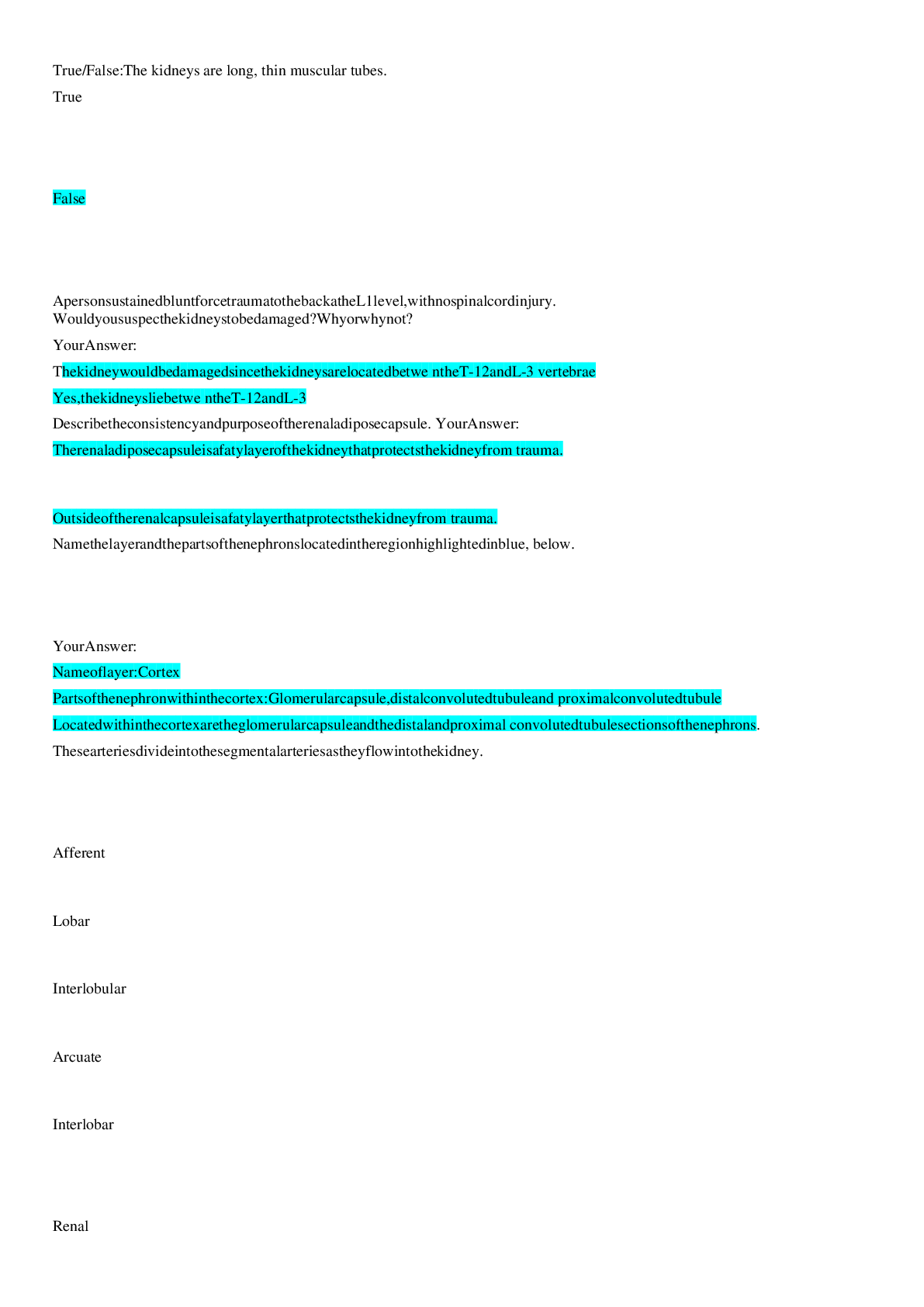
Buy this document to get the full access instantly
Instant Download Access after purchase
Buy NowInstant download
We Accept:

Reviews( 0 )
$16.00
Can't find what you want? Try our AI powered Search
Document information
Connected school, study & course
About the document
Uploaded On
May 17, 2022
Number of pages
20
Written in
Additional information
This document has been written for:
Uploaded
May 17, 2022
Downloads
0
Views
51



 Questions and Answers 100% VERIFIED.png)
 Questions and Answers 100% correct Solutions.png)






.png)


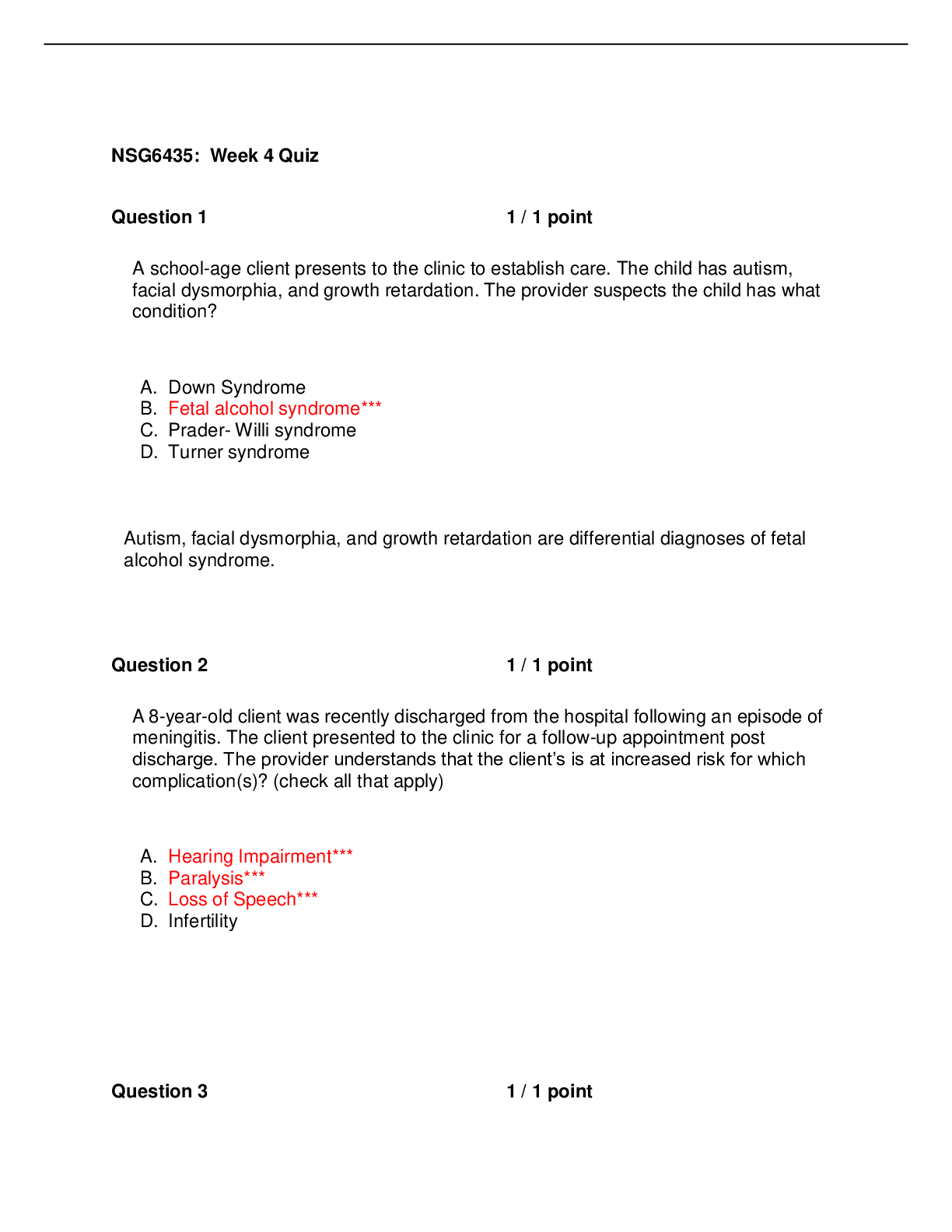
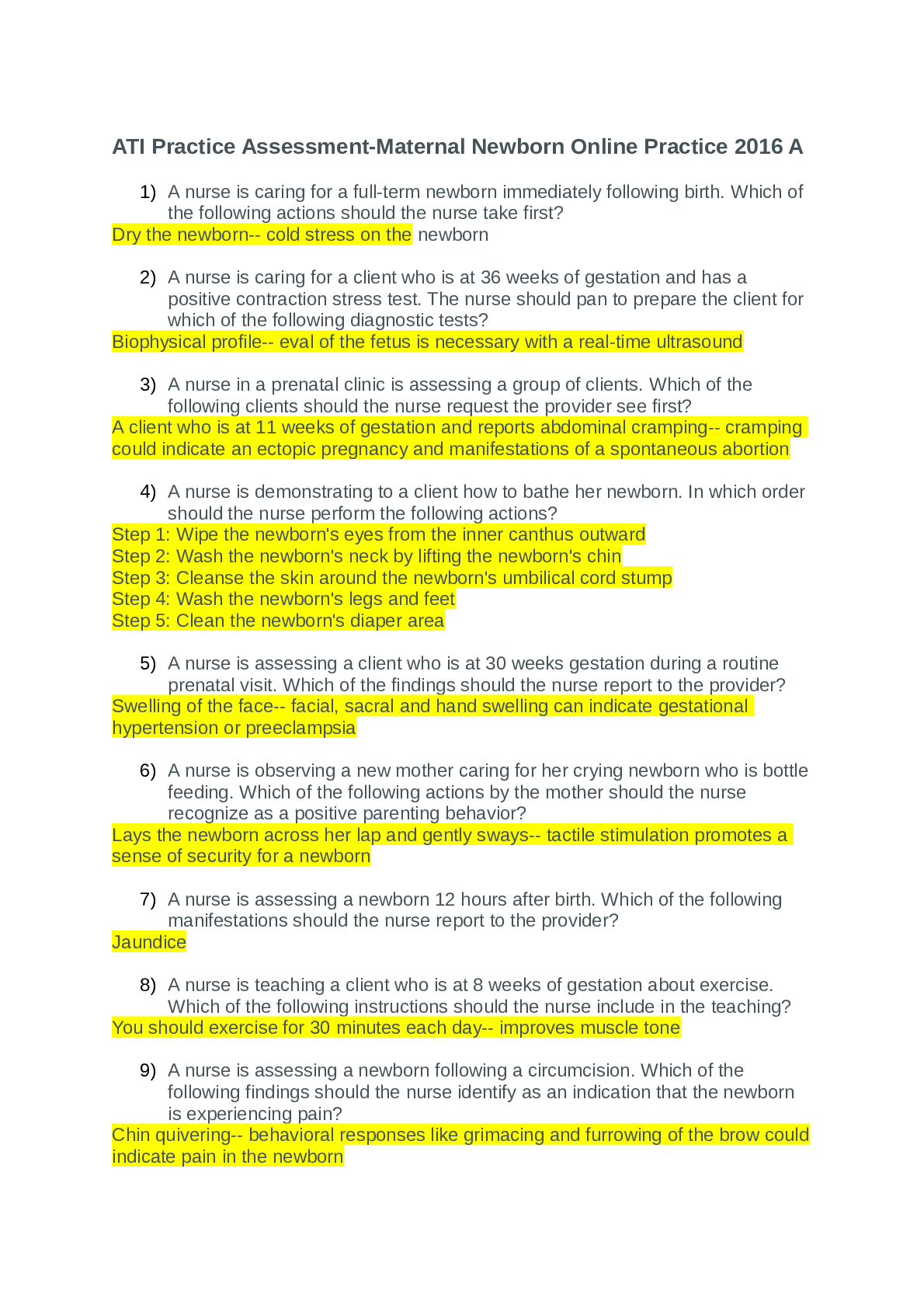
.png)
 60566.png)


 (1).png)

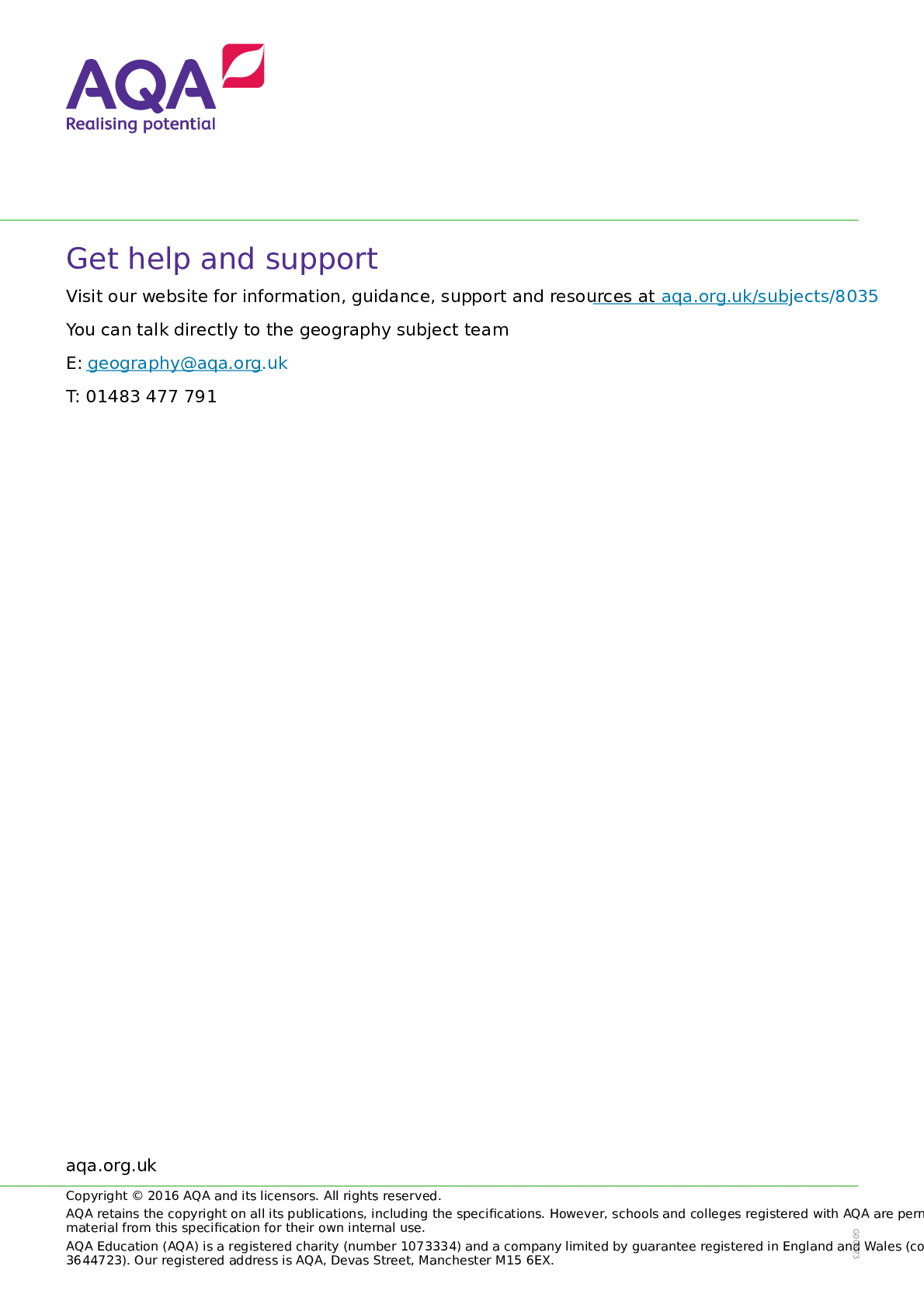
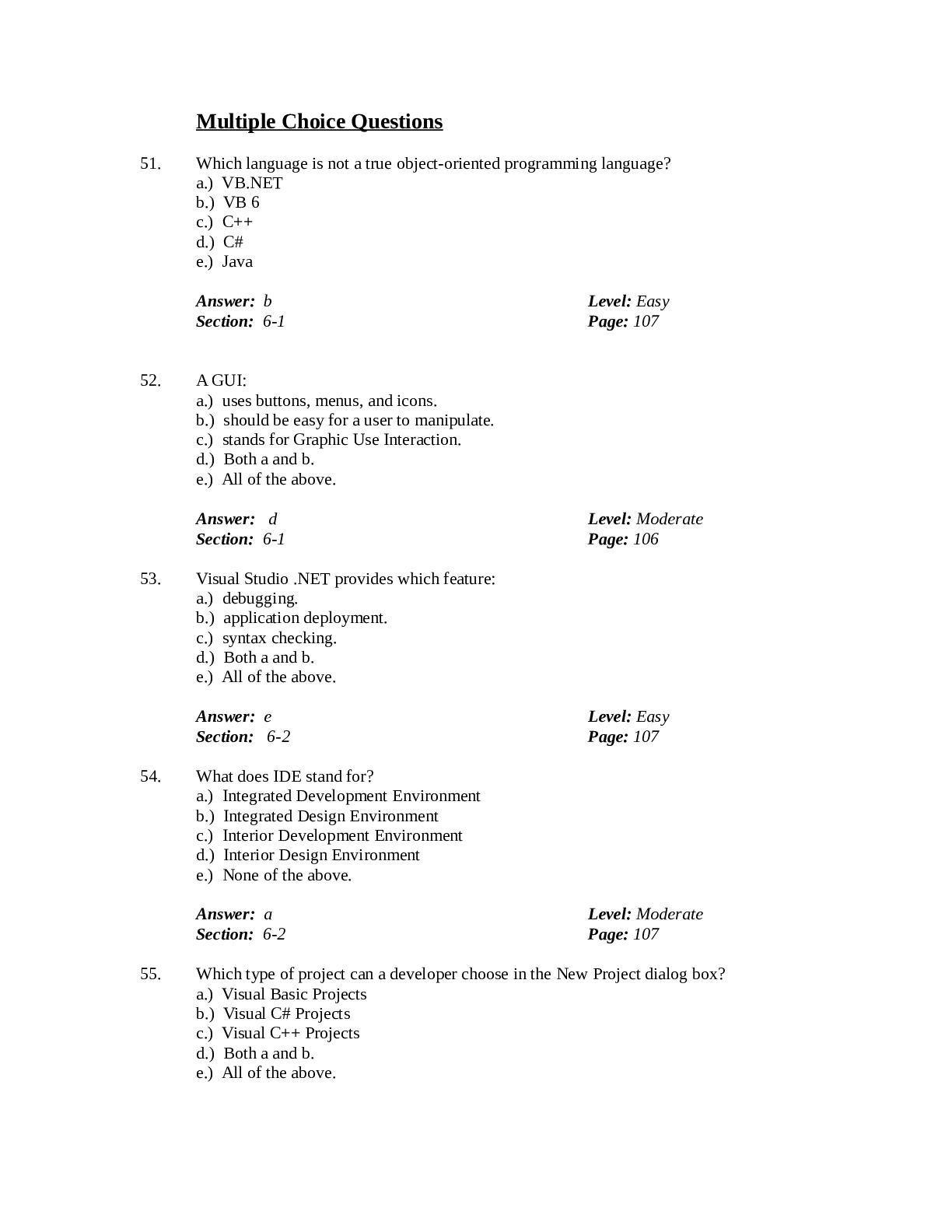
 (1).png)

